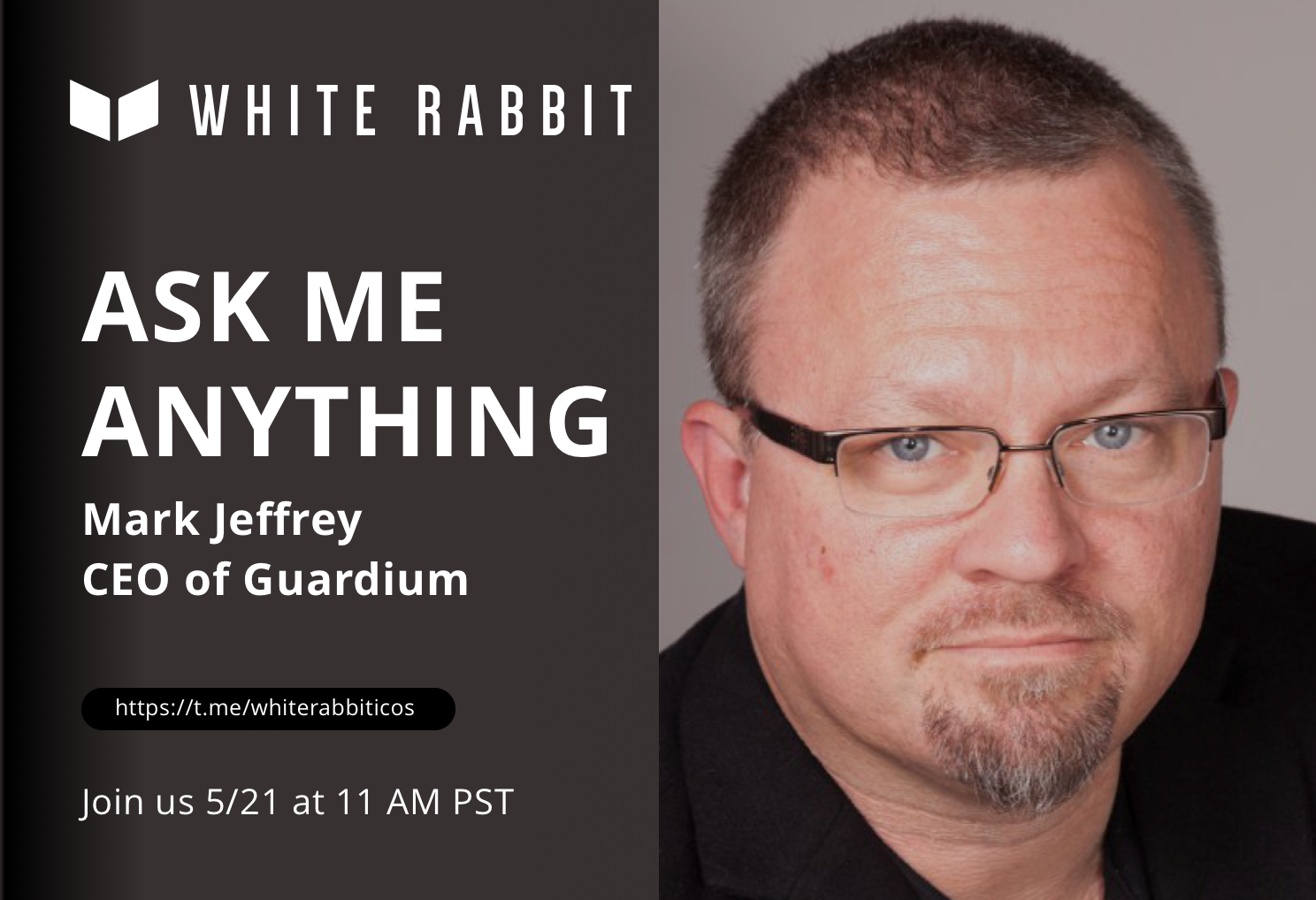Dmitriy Perelstein, White Rabbit (DP): Welcome to White Rabbit! Please introduce yourself and your project.
Mark Jeffrey, Guardium (MJ): My name is Mark Jeffrey. I'm CEO and Co-Founder of Guardian Circle (app) and its token, Guardium. GUARDIUM Token is global decentralized emergency response — universal 9-1-1. Mobile devices are used to create a 'flash mob of help' anywhere on earth. Working apps are released now worldwide on iOS, Android, and Amazon ALEXA. Six billion people have no 9-1-1. One billion do, but it is antiquated (1960's tech). We fix all of this. We open the emergency alert grid to vetted citizens, any alert device (via API) and private response services for the very first time. Basic service (unlimited friends, family and neighbors) is free; enhanced service is a small fee in Guardium, our token. This is pooled to create an Uber-ized semi-pro response service of EMT's, nurses, licensed and bonded private security, concierge alert operators, people with equipment (i.e. boats - think 'The Cajun Navy' in Texas hurricanes). Participants in the token sale to date in include DNA.fund, Victory Square Ventures and (one I cannot announce yet, but it is large — waiting on press clearance).
We are a NEO-based NEP-5 token. 🏆 WINNER:
- Fast Company 'World Changing Ideas' 2018
- CoinAgenda (Jan 2018)
- d10e: Gibraltar (Nov 2017)
- LAUNCH Festival (2016)
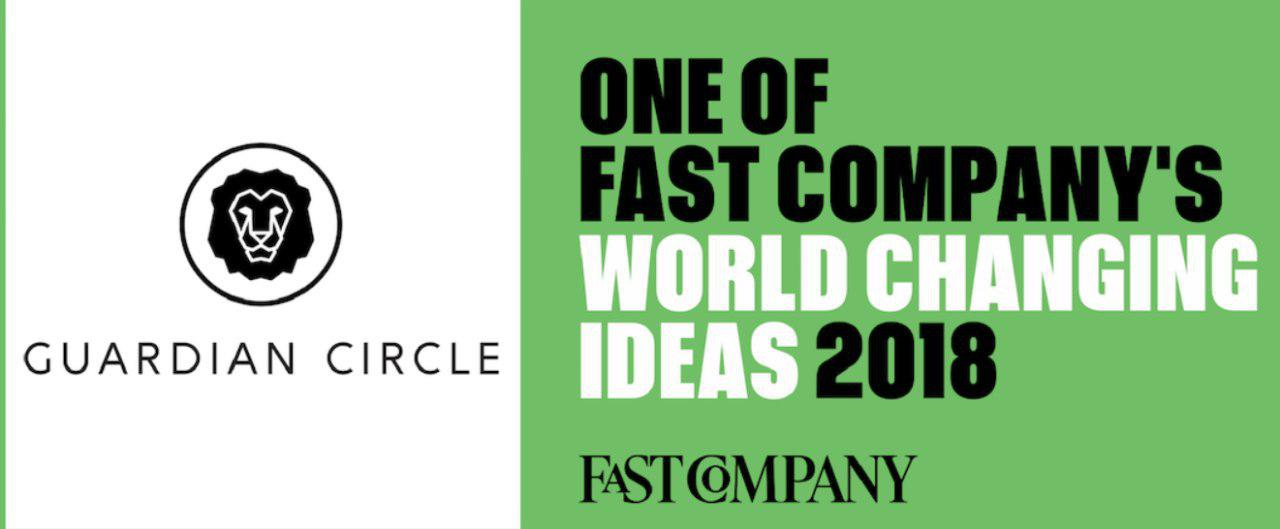
DP: This is great! Given the ever increasing amount of emergency events, there seems to be a higher and higher need for fast emergency response in the world.
MJ: There is. I just got back from India two weeks ago ... It's VERY sorely needed there.
DP: What have you been working on in india?
MJ: We are partners with the XPRIZE Foundation on the Women's Safety XPRIZE ... this is basically a 'panic button hardware' competition. We provide the Guardian Circle API to competitors — when you press the panic button, it sends your alert to our emergency grid, We then process the alert. We were there for the final rounds of device testing. 21 finalists — whittled down to 5. Testing occurred on the streets of Mumbai, on a train (to gauge accuracy of location reporting) and at the World Trade Center
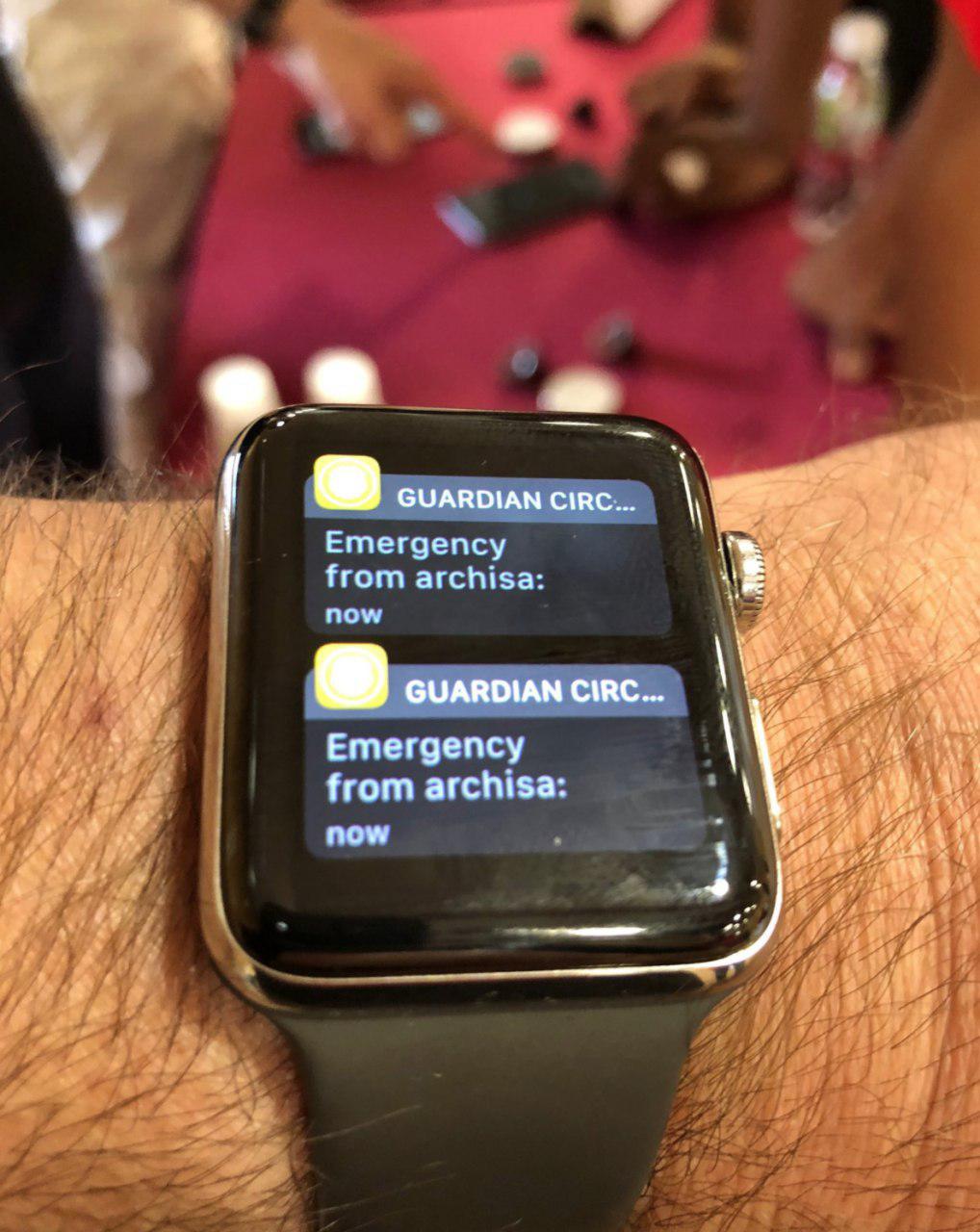
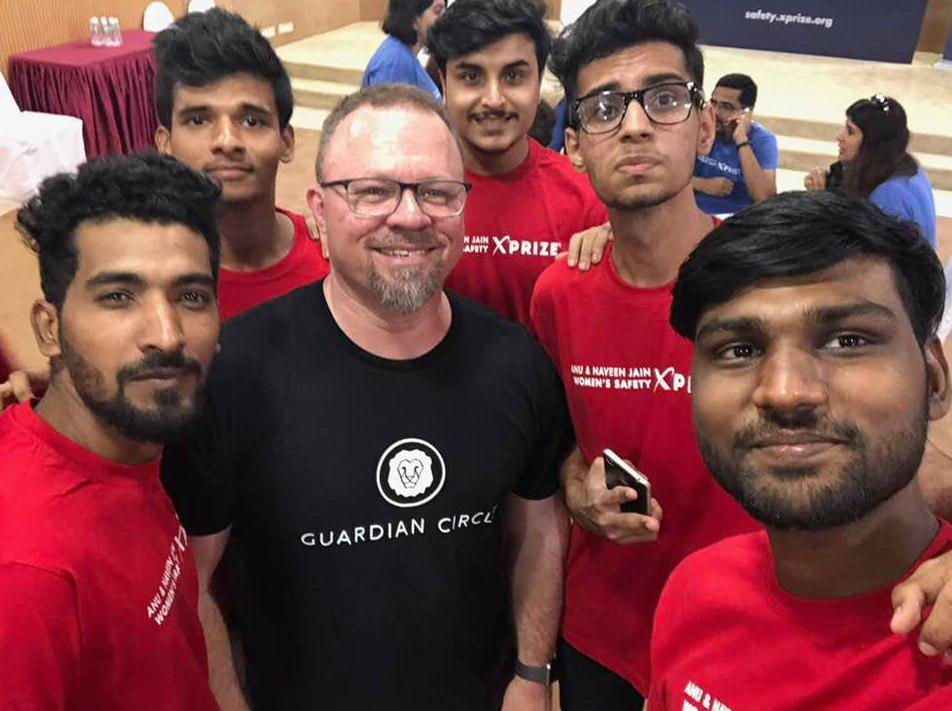
Elyse Lam: Why did you choose to build on NEO instead of Ethereum?
MJ: NEO is scalable now — 1000 transactions per second versus ETH's 21. All of our blockchain development will be easier and faster to develop on the NEO platform. Block generation takes only 15–20 seconds. Libraries For Integrated Wallet Development: We’re largely a Python shop, the City of Zion developers behind NEON are also big fans of Python. As a result, there are now actively developed open-source libraries that allow us to integrate an NEP-5 Guardium Token Wallet directly into Guardian Circle. This is a huge advantage over having to ‘roll our own’ from scratch (which we would have had to do with our old plan).
And this was a big one:
Separation of GAS and NEO: The price of gas for Ethereum has become outrageous and is already completely out of reach for the developing world. The NEO development team specifically wanted to avoid this situation, so they separated the GAS from the NEO tokens to keep transactions reasonably priced.
Lastly, the wallets in the NEO-verse are much better than those in the ETH-verse already. There are in-wallet token sales (which we are running now in Morpheus). Here are some examples (and compare this to MyEtherWAllet):
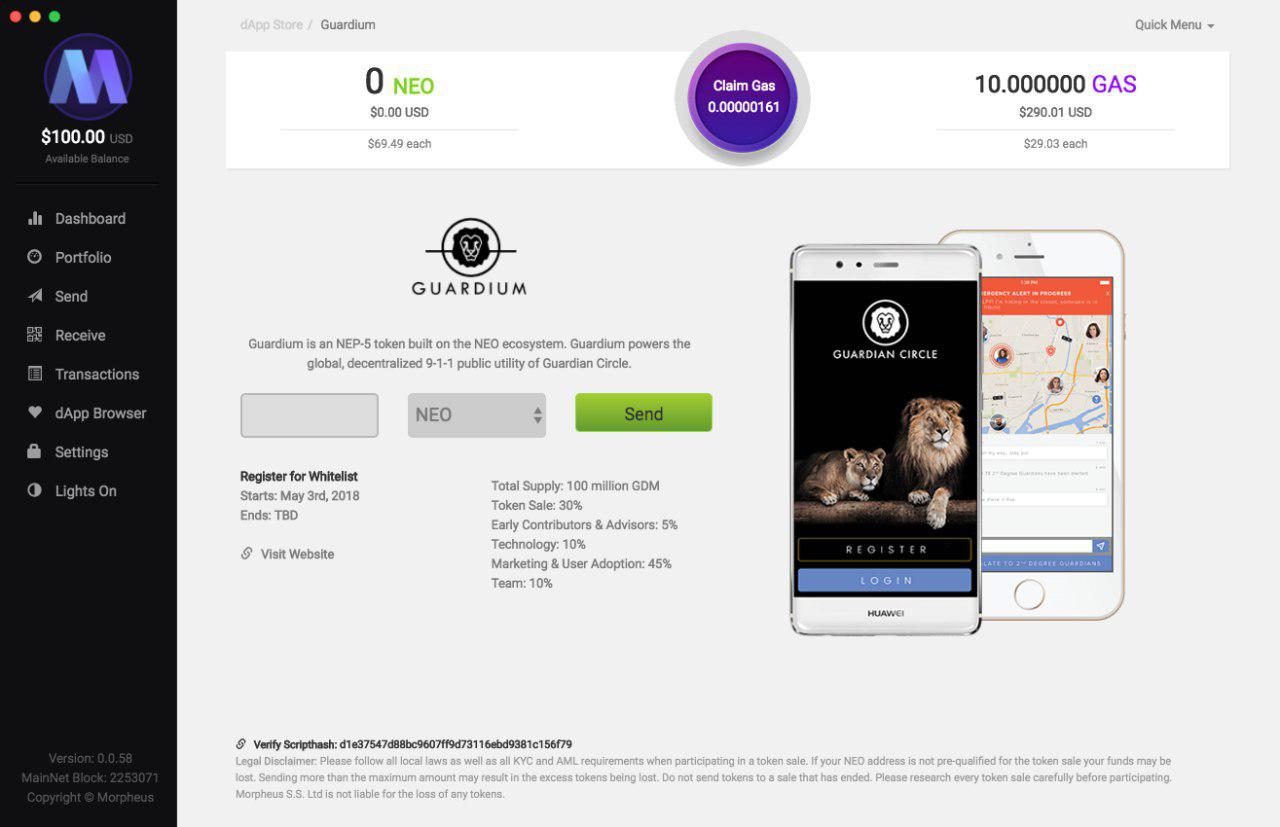
There is also the NEX decentralized exchange coming up ... A chrome extension wallet is the first step — in a few months, you'll be able to trade any NEP-5 token on it.
DP: I absolutely HATE how MEW looks like. It makes me feel like I use MS DOS in the early 90s.
MJ: Yep. MEW is like a space shuttle compared to these wallets. Morpehus is the slickest, NEON is the 'easiest' and simplest, 03 mobile is pretty good as well. All these wallets now support $GDM (Guardium) natively now.
DP: Do you think the fact that NEO is Asian based technology and a lot of your market is in Asia will help you scale as well?
MJ: We were a little scared of that at first, actually: Do we really want to bet on China? But the code is all open source — we can see what they're up to :) The advantages were super clear, so we decided to go with it — for now. I have no intention of changing chains, but it's not impossible if it were ever an issue. I think that the partnerships we're making with other NEO-based tokens will definitely help us penetrate China with Guardian Circle.
DP: So let’s go over a scenario. Let’s say a girl in India is being followed by a suspect. She presses a panic button on her device. What happens next?
MJ: Her alert goes up to the cloud. The cloud looks down and see what friends, family and neighbors are already nearby. It then activates, coordinates and pushes all that help to her. In 30 seconds, everyone is sharing location and communicating, coordinating a response. This is friends, family and neighbors. It might also be licensed and bonded private security. It might be EMT's on motorcycles. So QUALIFIED citizen response that is paid — in addition to volunteer / friends.
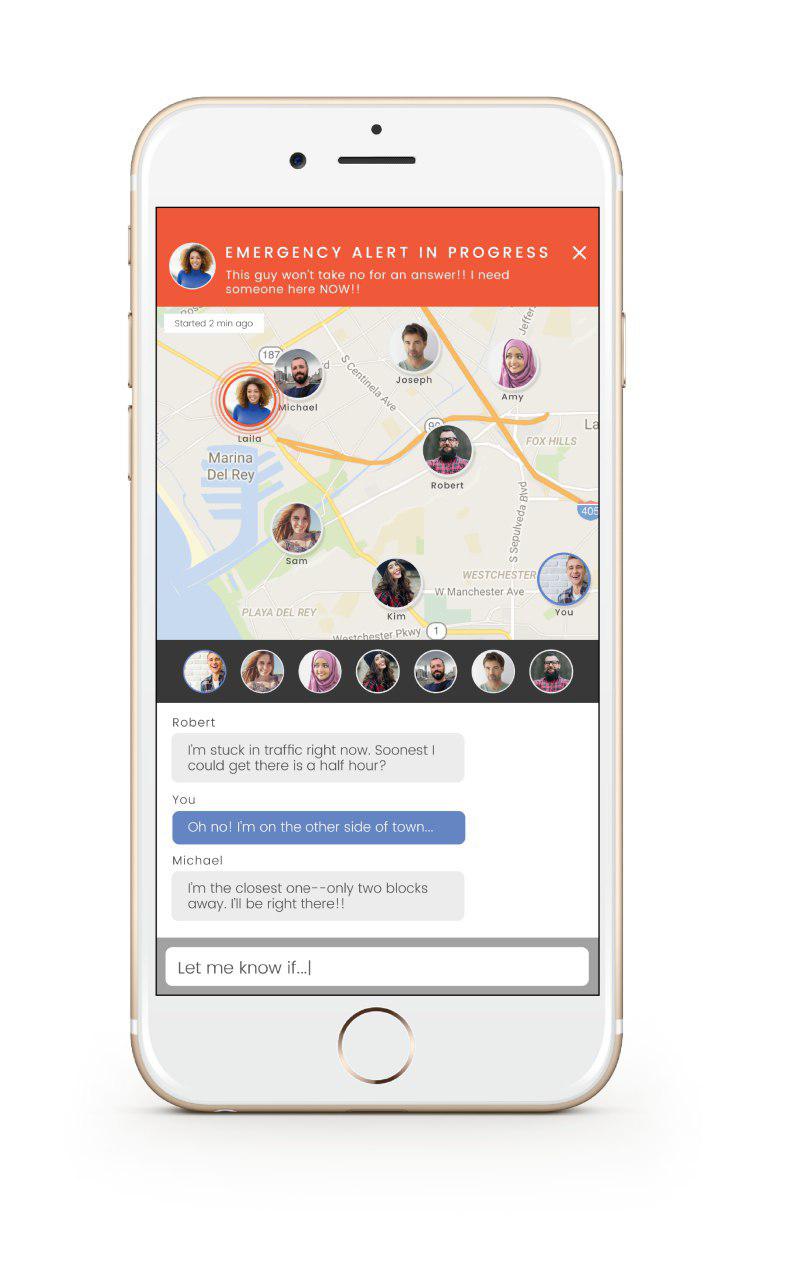
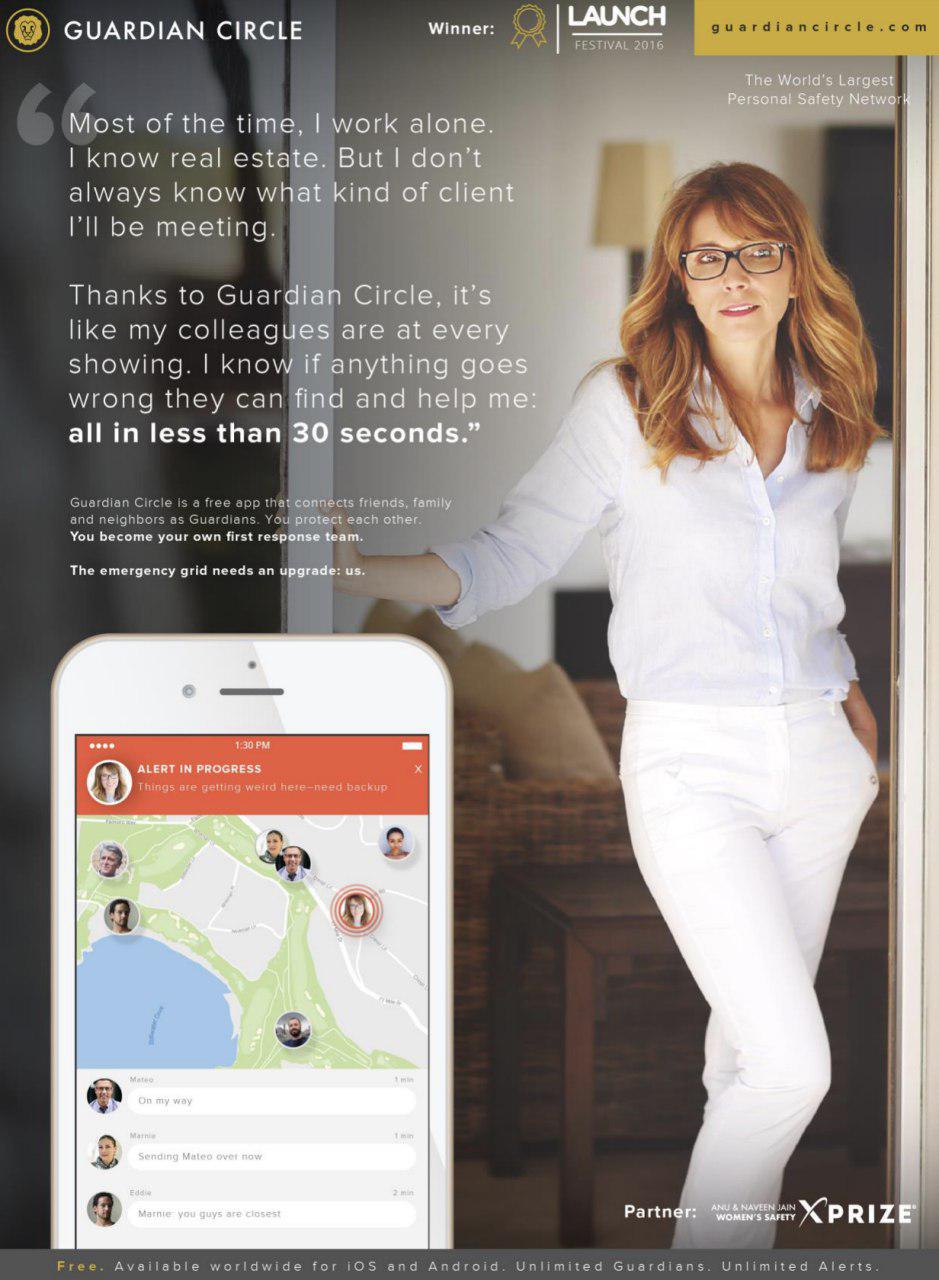
Or — if you want to use our Alexa app to trigger an Alert with your voice only. Basic Service is FREE, and always will be, worldwide. This includes:
Unlimited friends, family, neighbors in your Alert Circle. Have 6, 60, 600, 6000 — up to you.
Unlimited Alerts.
Beyond that, there is a marketplace of Paid Response Service subscriptions. Examples include:
- EMT / Paramedic
- Medical Transport
- Licensed & Bonded Private Security
- Rescue
- Remote Alert Operator (‘Concierge 9–1–1’ similar to LifeAlert)
- Public and Private Security from Governments / Municipalities / Campus Public Safety / Corporate Security firm
Full explanation of the tokenomics is here, btw: https://medium.com/@mark_11560/guardium-gdm-tokenomics-bca08e84a478
Elyse: How many users do you currently have in your existing app?
MJ: We have about 40K users of the apps worldwide at the moment ... but our deals with UpChannel and XPRIZE and others will push that into 50-100M range towards the end of this year. We have never done any marketing to date :) That will change. (combined with distribution deals)
DP: From 40K to 40M - whoa! In what time frame?
MJ: We think that will start end of this year and ramp throughout 2019. It depends on whether we hit our $10M cap and the speed at which our partners can mobilize on their end. There isn’t a shortage of willingness to help us get this out there to save lives, we've found.
Elyse: What regions will those partnerships cover?
MJ: India and South America primarily. We are working on a big one in China right now, but that is not done yet. Here is a video of XPRIZE team in India btw: https://www.youtube.com/watch?v=gqStw7tGPro
This will give you sense of what was up there :)
DP: What's the pricing model for your paid service? For the Americans using 911 it's kind of a weird feeling that we have to pay for emergency response services, no?
MJ: Not really. There are people who pay $30 / month for LifeAlert — which is the 'I've fallen and I can't get up!" thing. Concierge Alert Response is increasingly becoming needed and wanted. That's a $3B / yr industry in aggregate. Stanley Healthcare has a $3B / yr business just protecting medical / nurses with panic button security. 911 is outdated: when you call from a mobile device, your location is NOT SHARED with the operator (!!!!!!) If you don't know where you are, they cannot help you. And that's if you get through busy signals / etc.
DP: Do you have any projections for what will be the breakdown between paid and non-paid subscribers?
MJ: Dmitriy — we do not yet, no. Some of our subscription services will be experimental — for example, we have 2000+ EMT's in SoCal on motorcycles (to get through traffic). You don't need the full ambulance 90% of the time —- you need the EMT and a medkit. We send 3 EMTS every time — not just one — from three different directions. If you've never called 911, you probably don't know how terrible it actually is.
DP: at my prior job, we had to call 9-1 and then a phone number to call anyone. So one day someone dialed 9-1-1 by mistake a bunch of cops showed up in the office some time later. That was a land line though 😊
MJ: Yes landlines DO give location info. But who uses a landline nowadays?
DP: Unfortunately, old people do and those are the ones who need help a lot.
MJ: Unfortunately, old people do and those are the ones who need help a lot. But more importantly, we have an Open API.
Guardian Circle has an API that allows any Alert Device manufacturer to plug their Device into the Guardian Circle Alert Grid.
This API has already been used by ~100 contestants of the Women’s Safety XPRIZE, and to create an Amazon Alexa Voice version of Guardian Circle. Consumers can buy these devices, and pair them with their Guardian Circle accounts.
Example Devices:
Panic button jewelry: rings, bracelets, necklaces
A patch that automatically detects when you are in trouble
A watch that detects irregular heart-rate
A clip-on button that is 3G-enabled
In-car voice systems
To introduce a new device into the Guardium ecosystem, a Guardium stake is required.
So: Fall detection, Wander management, heart-rate monitoring — all coming. It's all about getting paid subscriptions using our tokenomics up and running successfully in a single geography first. Success stories, viable economics, etc. We may do this in India, SoCal, Puerto Rico, Mexico or Brazil. All have advantages / disadvantages. We definitely will be fully rebooting the apps and building the Responder Marketplace and $GDM wallets into them all. That we do next for certain.
DP: Who do you see as your main competitors?
MJ: Different in different regions of the world — sometimes gov-supplied emergency response, sometimes private ambulance co's, sometimes panic button apps. NONE of these, however, had done ANYTHING with a token / blockchain yet. We are entirely unique there. We are the only ones to supply an API for devices and responders.
DP: Right. So what is the use case for blockchain-type solution? Why do you need a token and not just have a paid subscription?
MJ: We are the only ones who 'organize the response' with an Alert Room — no one else does that. We slam together all these people into location sharing and communication — and this is the important part == without requiring them to know each other ahead of time. Everyone else simply sends a text message: "Mark is in trouble! Click here to help him!!!" Now, nobody is going to click Suspicious Probably Spam Link. But they WILL call you. So: you're dying, and you now have 20 inbound calls. This does not help you at all.
Payment:
- You can pay for these subscriptions using fiat (credit card, etc.)
- Or, pay in Guardium ($GDM) and receive a 50% discount.
- Or, if you stake Guardium ($GDM) in your app wallet (lock up a certain amount of $GDM for a certain amount of time), pay in fiat and receive a 20% discount.
Consumers can EARN Guardium by:
- Inviting new users to download Guardian Circle and sign up for the free service.
- Converting free users to paid subscriptions.
- Answering Alerts from friends, family and neighbors.
Thus, it is possible for users to be effectively subscribed to paid subscriptions for free forever by continually helping to expand the ecosystem. The intent is that the earliest Paid Response Service Providers to participate will receive outsized rewards, via their ownership of Guardium, as the entire eco-system expands. GIVING:
It is imagined that caused-based, impact ‘remote sponsorship’ of safety in the developing world will be a big behavior in our ecosystem.
Example: Sponsor women’s safety in India
Sponsorship requires the purchase of Guardium. A website for doing this — along with a way to specify the target region and cause — will be provided by Guardian Circle.
The Sponsor’s Guardium is then sent directly to beneficiaries in need around the world, who can then use it to purchase Paid Response Services. Since the Guardium does not flow through a bank, a government or an organization, the Sponsor knows their gift was not spent inefficiently or inappropriately.
Furthermore, the Sponsor can see exactly how their gift was spent via a ‘human readable’ Guardium blockchain explorer. Sponsors are thus able to track every donated dollar as easily as a FedEx package.
This radical transparency, we believe, will open a floodgate of giving. This should also provide a healthy flow of fiat-to-Guardium.
Alert Transcript — Immutable Capture and Custody:
Consumer alert transcripts are stored encrypted in the blockchain. Transcripts contain timestamps of when the alert was created, who responded at what time, a record of all conversations, and the full location information of alerter and responders during the alert.
Custody is retained by the consumer. Consumer decides who — if anyone — views the transcript. A log is kept of who viewed and when.
Blockchain makes the alert transcript immutable. This means corrupt law enforcement cannot alter evidence. It is a perfectly truthful and provably accurate record of events.
This service is provided for free, but requires a stake of $GDM to establish and keep active.
Emergency Information Lockbox:
Consumers may ‘bank’ information they wish only to be released during an emergency.
Examples: Secret health issue, where the key is hidden in the front yard, combination to a safe, etc.
This is stored encrypted on the blockchain with a two-key, multi-sig release mechanism. Declaring an Alert turns one key. Designated recipients answering the Alert turns the second key, thereby unlocking the information for ‘their eyes only’.
Because it is stored on a blockchain, this extremely sensitive information is much safer than in a centralized data store. It is theoretically unhackable (one would have to hack the entire blockchain, which to date, has never happened).
This service is provided for free, but requires a stake of $GDM to establish and keep active.
Here is an early version of "Guardian Circle DISPATCH" for emergency responders:
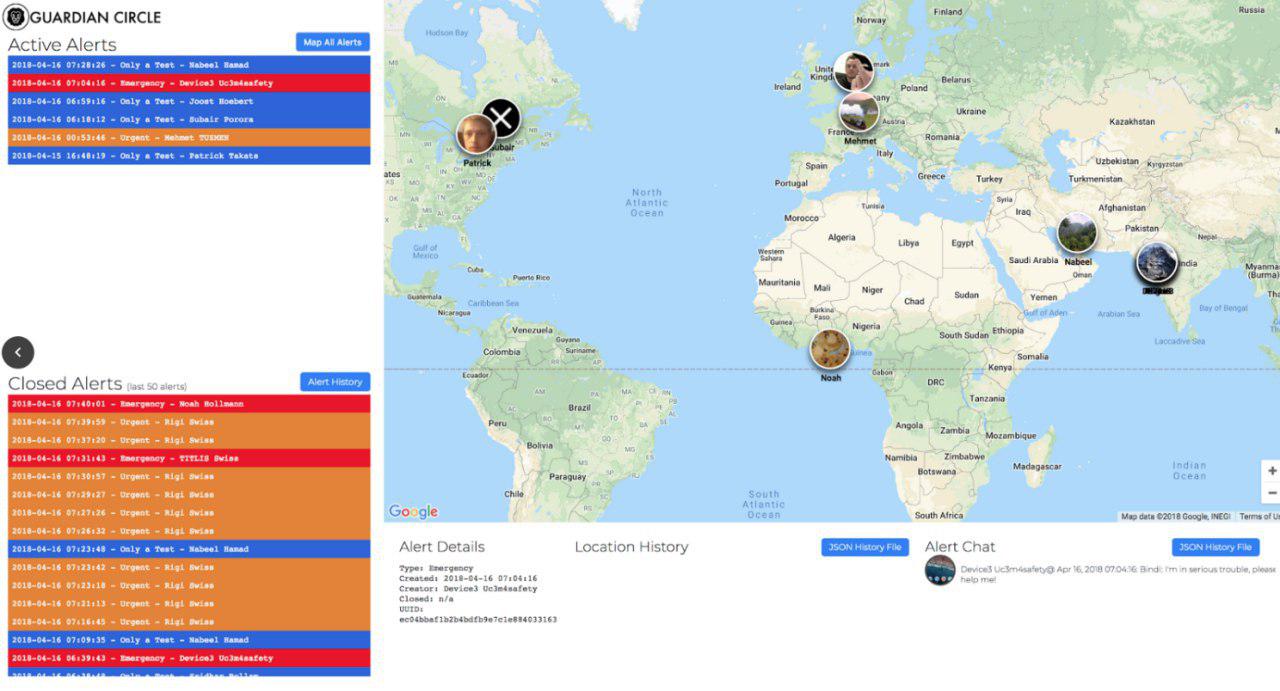
This is LIVE data from the actual GC system btw. This is NOT a mockup. With devices:
To introduce a new device into the Guardium ecosystem, a Guardium stake is required.
The stake is tied to a GDM address, which then becomes tied to an API key.
The amount of GDM stake required increases with the number of devices powered by the API key. For example:
Up to 10,000 devices: 30,000 GDM stake
Up to 30,0000 devices: 60,000 GDM stake
Etc.
As with Paid Response Services, the earlier Alert Device Manufacturers will get a ‘better deal’ in terms of their stakes. The intent is that the earliest Alert Device Manufacturers to participate will receive outsized rewards, via their ownership of Guardium, as the entire eco-system expands.
Kurt: Interested in learning more about the dev tools 🏆
MJ: The API is ready to go and documented :) We'll send you the stuff :) That's what these guys used — this is a 'patch' that detects when someone is under attack and generates an Alert over 3G.
DP: Can you tell us about your team? I saw that you have a lot of startup experience. How did you come up with the idea and who's helping you?
MJ: Chris Hayes CTO and CoFounder is our main guy. He has recently brought on two more devs to help him out. I'm also working with Christina Allen (early LinkedIN product VP) to design our next-gen product. We will hire first in engineering once the token sale is done. Marketing will be next — but that decision must be informed by the geography we are targeting first, as this will be a very different skillset depending on what beachhead we select.
Advisors: Michael Terpin, Ryan Scott, Fred Kruegar, William Mougayar, Miko Matsumura, Crystal Rose-Pierce, Ken Brook, Richard Titus.
Investors: Princess Khaliya, Eric Pulier, Michael Terpin, John Valenti, Jason Calacanis. I came up with the idea after my girlfriend had a stroke-like event. And she was all alone — yet 7 people were within 1000 yards of her. The full story is here: http://guardiancircle.com/our-story.html.
DP: wow, impressive. Your advisory board looks like Who's Who in the world of Crypto. How did you manage to score all of these big names?
MJ: I've worked with many of them over the last 10-20 years, we're all old friends with the exception of Mougayar — who is a very good friend of a very good friend.
DP: Also, tell us about your Token Generation Event - what stage of token sale are you in now?
MJ: We are in the last two weeks of the token sale. It ends June 1. We are selling 30M tokens — we're sold roughly 40% of that. Whatever we don't sell of that 30M is burned. We have two very big announcements that I am waiting for press clearance on. In the past, these same announcements made by others have sold out the remaining tokens within days — so I'm hopeful that will happen here. Very big and well-known token sale participant in one case. Name brand. And the second is a new Advisor and Token Sale Participant who is famous. So — everything takes longer than I would like :) I am hopeful that I will get clearance early this week — press releases have been drafted and are ready to drop.
DP: BTW, I am surprised that @fredj did not convnce you to use EOS rather thhan NEO as your platform. He is a big proponent :)
MJ: I am a huge fan of EOS. I HODL a bunch of EOS personally. It was heart-breaking personally to NOT go EOS — those guys are my friends — but the cold hard practical advantages of going NEO were far too large to ignore.
Elyse: What practical advantages?
MJ: We discussed earlier — the full answer is here: https://medium.com/guardian-circle/guardium-token-is-moving-to-neo-94a17cc5b8f0
Elyse: i meant between NEO and EOS 🙂
MJ: Well — NEO is launched now, scalable now, has several wallets and exchanges now, has an active dev and investor community (City of Zion, Morpheus. ect.)
DP: What other crypto projects do you really like?
MJ: My picks are: NEO, EOS, QLINK, FunFair, BinanceCoin, WorkCoin, Metal, Civic.
DP: Who can participate in your token sale? American accredited investors are ok?
MJ: They are not. Unfortunately, we cannot allow US-based participation. Which we hate. The US is making that impossible via FinCEN money transmitter laws, not SEC accreditred vs. non-accredited. I am so sorry — I would love to able to take US participants. This is the issue: https://bitcoinmagazine.com/articles/fincen-deals-major-regulatory-blow-icos-and-exchanges/
DP: ok @markjeffrey thank you very much for your time today! And good luck with your project!

